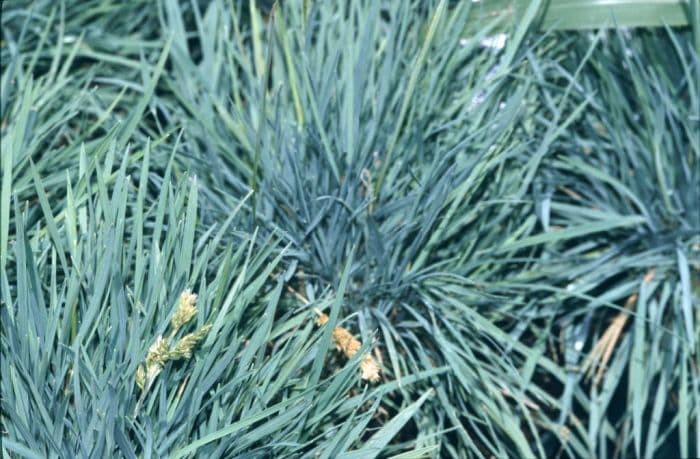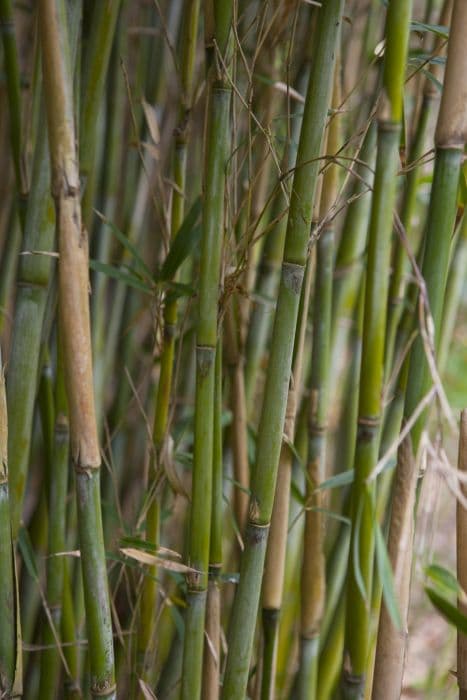Blue Hair Grass Koeleria glauca

ABOUT
Koeleria glauca, commonly known as blue hair grass, is a perennial grass that is noted for its attractive foliage and tufted growth habit. The plant typically features fine, narrow leaves that have a blue-green or glaucous hue, giving it a distinctive silvery appearance. Its coloring can add a unique, cool-toned touch to garden landscapes. The leaves are often tightly packed together at the base, forming a dense clump from which new growth emerges. During its flowering season, blue hair grass produces slender, upright flower spikes that rise above the foliage, offering a delicate texture to the plant profile. These flower spikes can add a feathery, airy quality to the overall appearance of the plant. After the blooming period, the flowers may turn into a light brown or tan color, which can provide visual interest even when the plant is not in active growth or bloom. Though specific dimensions are excluded, it is worth noting that the overall form of the plant can be described as compact and mound-forming, which makes it suitable for various garden uses, such as edging, groundcover, or use in rock gardens. The foliage and the flowering spikes together contribute to the ornamental appeal of the plant throughout its growing season.
About this plant
 Names
NamesFamily
Poaceae
Synonyms
Blue Koeler's Grass, Crested Hair-Grass, Glaucous Hair-Grass
Common names
Koeleria cristata var. glauca, Koeleria vallesiana, Koeleria glauca ssp. sergievskajae, Koeleria gracilis Pers.
 Toxicity
ToxicityTo humans
Blue Hair Grass (Koeleria glauca) is not known to be poisonous to humans. There are no well-documented cases of toxicity or symptoms of poisoning linked to the ingestion of any part of this particular plant. However, it is generally advisable to avoid ingesting plants that are not known to be edible.
To pets
Blue Hair Grass (Koeleria glauca) is also not known to be toxic to pets. It is not typically listed among plants that pose a risk of poisoning to animals such as dogs or cats. Therefore, there are no specific symptoms of poisoning associated with this plant for pets. Pet owners should still be cautious, as individual animals might have sensitivities or allergic reactions to plants that are typically considered non-toxic.
 Characteristics
CharacteristicsLife cycle
Perennials
Foliage type
Deciduous
Color of leaves
Blue-green
Flower color
Varies
Height
1-2 feet (0.3-0.6 meters)
Spread
0.5-1 feet (0.15-0.3 meters)
Plant type
Herb
Hardiness zones
4
Native area
Europe
Benefits
 General Benefits
General Benefits- Ornamental Value: Koeleria glauca, commonly known as Blue Hair Grass, adds aesthetic appeal to gardens with its attractive bluish-green foliage and delicate flower spikes.
- Drought Tolerance: This plant is highly tolerant of dry conditions, making it suitable for xeriscaping and low-water gardens.
- Erosion Control: Due to its clumping growth habit, Blue Hair Grass can help stabilize soil and prevent erosion on slopes and hillsides.
- Wildlife Habitat: It provides shelter and nesting materials for small wildlife, including birds and beneficial insects.
- Low Maintenance: Koeleria glauca requires minimal care once established, making it an ideal choice for gardeners seeking low-maintenance landscaping plants.
- Cold Hardy: Blue Hair Grass can withstand cold temperatures, making it suitable for growth in various climates and a good choice for year-round interest in temperate gardens.
- Versatility in Landscaping: It can be used in rock gardens, borders, and as a groundcover, offering flexibility in garden design.
 Medical Properties
Medical PropertiesThis plant is not used for medical purposes.
 Air-purifying Qualities
Air-purifying QualitiesThis plant is not specifically known for air purifying qualities.
 Other Uses
Other Uses- Koeleria glauca, commonly known as Blue Hair Grass, can be used as ground cover in gardens due to its ability to create a dense mat that suppresses weeds.
- The plant's dense tufts are sometimes used in creating habitats for small ground-nesting birds, offering protection and a nesting area.
- Blue Hair Grass is often used in xeriscaping, a landscaping method that reduces or eliminates the need for supplemental water from irrigation.
- The fibrous roots of Blue Hair Grass can help in soil erosion control by stabilizing loose soil on hillsides and in areas prone to erosion.
- Landscape designers may use this ornamental grass for its texture in rock gardens, where it complements the rugged features of the stones.
- It's included in rooftop gardens, as its tolerance for dry conditions fits well with the challenging microclimates on roofs.
- The plant can be used in floral arrangements, both fresh and dried, because of its elegant and slender foliage.
- Koeleria glauca can be used as a living mulch, its foliage shading the soil and helping to maintain moisture levels during hot weather.
- The standing dead foliage of Blue Hair Grass provides winter interest in gardens and can serve as shelter for beneficial insects during the cold months.
- Gardeners may use this plant along pathways or borders for its contrasting blue-green hue that helps define garden spaces.
Interesting Facts
 Feng Shui
Feng ShuiThe Blue Hair Grass is not used in Feng Shui practice.
 Zodiac Sign Compitability
Zodiac Sign CompitabilityThe Blue Hair Grass is not used in astrology practice.
 Plant Symbolism
Plant Symbolism- Resilience: Koeleria glauca, commonly known as Blue Hair Grass, often grows in poor soils and challenging conditions, symbolizing the ability to thrive despite difficulties.
- Peace: The soft, bluish hue of Blue Hair Grass can represent tranquility and calmness, evoking a peaceful ambiance wherever it grows.
- Grace: The delicate and fine foliage of Blue Hair Grass can symbolize elegance and grace, adding a touch of beauty to the landscape.
- Simplicity: Its low maintenance and unassuming appearance embody the essence of simplicity and modesty in one's character or life.
- Adaptability: Adaptability is another trait associated with Blue Hair Grass, as it can adjust to various environments, illustrating the importance of being versatile and flexible in life.
 Water
WaterThe Blue Hair Grass (Koeleria glauca) should be watered deeply yet infrequently to mimic its natural dry habitat. Allow the soil to dry out slightly between waterings. Generally, this will mean watering approximately once a week during the active growing season, using about one gallon per plant, depending on the size and environmental conditions. During the winter dormancy period, reduce watering to every few weeks, monitoring the moisture level of the soil to prevent overwatering and potential root rot.
 Light
LightBlue Hair Grass thrives best in full sun conditions, with at least six hours of direct sunlight daily. Plant it in a spot that receives unfiltered, strong light throughout the day to encourage robust growth and the development of its characteristic blue-grey foliage.
 Temperature
TemperatureBlue Hair Grass is hardy and can tolerate a range of temperatures but ideally prefers temperatures between 60°F and 75°F. It can survive minimum temperatures down to about -20°F and maximum temperatures as high as 90°F, provided it is not for prolonged periods.
 Pruning
PruningPruning Blue Hair Grass is important to maintain its compact shape and encourage new growth. Trim back the grass in late winter or early spring before new shoots emerge. Pruning once a year is sufficient. The best time is when you can see new growth starting at the base while the old foliage is looking tattered.
 Cleaning
CleaningAs needed
 Soil
SoilJune grass prefers a well-drained sandy or loamy soil with a neutral pH between 6.0 and 7.5. A mix containing 2 parts sand, 1 part loam, and 1 part compost would be ideal for June grass, providing good aeration and nutrients.
 Repotting
RepottingJune grass, once established, typically does not require frequent repotting. It should be repotted every 2-3 years or when the root system outgrows the container.
 Humidity & Misting
Humidity & MistingJune grass tolerates a wide range of humidity levels and does well in average ambient air conditions without the need for specialized humidity control.
 Suitable locations
Suitable locationsIndoor
Place in a well-lit area and water moderately.
Outdoor
Choose a sunny spot, water as needed, and protect from strong winds.
Hardiness zone
3-9 USDA
 Life cycle
Life cycleKoeleria glauca, commonly known as blue hair grass, begins its life cycle when the mature plant produces seeds, typically through a process involving flowering and pollination. These seeds then disperse, often by wind or animal activity, and settle in suitable soil where they undergo a period of dormancy until conditions prompt germination. Upon germination, the seedlings emerge, developing roots and shoots as they establish themselves in their new environment. As they grow, blue hair grass develops characteristic narrow, blue-green leaves and forms tufted clumps. Following vegetative growth, the plants reach maturity and enter the reproductive stage, producing flowering stems topped with narrow, plume-like panicles (flower clusters). After pollination, seeds develop and are eventually released to begin the cycle anew.
 Propogation
PropogationPropogation time
Spring to early summer
For Koeleria glauca, commonly known as blue hair grass, the most popular method of propagation is through seed sowing. Seed collection should ideally take place when the seed heads are ripe, typically in late summer or early fall. Sowing can be done immediately in well-drained soil in a sunny location either in containers or directly in the garden bed. The seeds should be lightly covered with soil, as they need some light for germination, and keep moist until germination, which usually happens within 2 to 3 weeks. For best results, maintain the soil temperature around 70 degrees Fahrenheit (21 degrees Celsius). Thin the seedlings to avoid overcrowding, which allows the plants to establish a strong root system.









